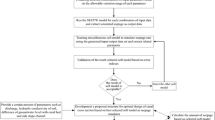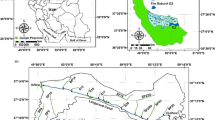Abstract
The Upper Swat Canal (USC) System became operational in 1917–1918 in North West Frontier Province (NWFP) of Pakistan. The rehabilitation and modernization of the USC was undertaken with a view to overcoming the shortage of water supplies for irrigation. The water allowance was enhanced from 0.39 to 0.77 Ls−1 ha−1 in the study area. Recently, the operation and management of a secondary canal or ‘distributary’ was transferred to the Farmers Organization (FO). This distributary named ‘Chowki’ offtakes from the Maira Branch of the USC. The cultivable command area (CCA) of this distributary is 4,306 ha and it serves 1,485 beneficiaries. A management committee on Chowki Distributary was formed in 2003. This distributary consists of one main and two minor channels having twenty-eight direct outlets. The Simulation of Irrigation Canal (SIC) hydrodynamic model was used to evaluate the flexibility of Chowki Distributary. The model was calibrated at 100, 80 and 70% of the design discharge (Q d) and it was validated at 90, 85 and 60% of the design discharge. The observed and simulated water levels were in close agreement with each other for the calibration and validation periods. The statistical analysis and paired t-test indicate that the model results are not statistically different from the measured values at 1% significance level. The simulated results of the SIC model were applied to studying flexibility of the outlet structures along the Chowki Distributary. The flexibility analysis demonstrates that poor performance is inbuilt into the system due to inadequate control over the accuracy of the crest setting during the construction of the outlets.




Similar content being viewed by others
Notes
Adjustable Orifice Semi-Module (AOSM) may be regarded as a long throated flume with a roof block capable of vertical adjustment in the upstream end of the parallel throat; the roof block is suitably shaped to ensure converging streamlines so that the discharge coefficient does not vary much. Supercritical flow through the orifice causes the formation of hydraulic jump in the expanding flume and, hence, the outlet discharge remains independent of the water level in the watercourse (Kraatz and Mahajan 1982).
References
Ali I (1993) Irrigation and hydraulic structures: theory, design and practice. Inst Environ Eng and Res. Pakistan, pp 301–343
ASCE (1993) Criteria for evaluation of watershed models. J Irrig Drain Eng 119(3):429–442
Badruddin M (1993) An overview of irrigation in Pakistan. IIMI, Pakistan
Baume JB, Malaterre PO, Vion PY, Litrico X (2003) Simulation of irrigation canals. Agric and Environ Eng Res. CEMAGREF, France
Bhutta MN, Kijne JW (1990) Application of a hydraulic model for testing management decisions at distributary level. Irr Sci 13:15–20
Gilmartin D (1994) Scientific empire and imperial science: colonialism and irrigation technology in the Indus basin. J Asian Stud 54:127–1149
Horst L (1998) The dilemmas of water division: Consideration of criteria for irrigation system design. Int Water Management Institute, Sri Lanka, pp 15–25
Kraatz DB, Mahajan IK (1982) Small hydraulic structures. Irrigation and drainage paper no. 26/1. Water Resour Dev and Manage Serv. FAO. Rome
Kumar P, Mishra A, Raghuwanshi NB, Singh R (2002) Application of unsteady flow hydraulic model to a large and complex irrigation system. Agric Water Manag 54:49–66
Kuper M, Kijne JW (1992) Irrigation management in the Fordwah Branch Command area. Southeastern Punjab, Pakistan. In: Advancements in IIMI’s Research 1992: International Irrigation Management Institute, Colombo, pp 1–24
Michel AA (1967) The Indus Rivers: a case study of the effects of partition. New Haven and London, Yale University Press
Mishra A, Anand A, Singh R, Raghuwanshi NS (2001) Hydraulic modeling of Kangsabati main canal for performance assessment. J Irrig Drain Eng ASCE 127(1):27–34
Molden DJ, Makin IW (1996) Institutional change in support of modernization and management transfer. Modernization of irrigation schemes: past experiences and future options. Proceedings of the expert consultation, FAO, Thailand
Moriasi DN, Arnold JG, Van Liew MW, Bingner RL, Harmel RD, Veith TL (2007) Model evaluation guidelines for systematic quantification of accuracy in watershed simulations. Trans ASABE 50(3):885–900
Nash JE, Sutcliffe JV (1970) River flow forecasting through conceptual models: part 1. A discussion of principles. J Hydrol 10(3):282–290
Renault D (1999) Offtake sensitivity, operation effectiveness, and performance of irrigation system. J Irrig Drain Eng ASCE 125(3):137–147
Renault D, Makin IW (1998) Modernization of irrigation systems operation: a desegregated approach of the demand. In: Proceedings of the fifth international meeting of ITIS network, India
Renault D, Hakeem AK, Hemakumara MH, Asghar MM (2001) Assessing sensitivity factors of irrigation delivery structures. J Irrig Drain Eng ASCE 127(6):346–354
Rust HMD, Halsema GE (1998) Effect of construction defects on hydraulic performance of Kalpani distributary, NWFP Pakistan. Irrig Drain Syst 12(4):323–339
Shahrokhnia MA, Javan M (2005) Performance assessment of Doroodzan irrigation network by steady state hydraulic modeling. Irrig Drain Syst 19:189–206
Shanan L (1992) Planning and management of irrigation systems in developing countries. Agric Water Manag 22(2):113–145
Strosser P (1997) Analyzing alternative policy instruments for the irrigation sector: an assessment of the potential for water market development in the Chishtian sub-division. Dissertation, Wageningen Agricultural University
Vermillion DL, Restrepo CG (1996) Results of management turnover in two irrigation districts in Columbia. Research report 4. International Irrigation Management Institute, Sri Lanka
Walpole RE, Myers RH (1989) Probability and statistics for engineers and scientists. Macmillan, New York
World Bank (1994) Pakistan irrigation and drainage: issues and options. Report no. 11884-PAK. Washington, DC
Author information
Authors and Affiliations
Corresponding author
Additional information
Communicated by T. Trooien.
Rights and permissions
About this article
Cite this article
Tariq, J.A., Latif, M. Flexibility analysis of irrigation outlet structures using simulation of irrigation canal hydrodynamic model. Irrig Sci 29, 127–134 (2011). https://doi.org/10.1007/s00271-010-0222-8
Received:
Accepted:
Published:
Issue Date:
DOI: https://doi.org/10.1007/s00271-010-0222-8




